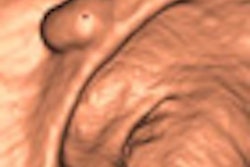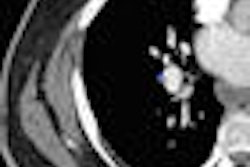Patients who are scanned frequently with CT are exposed to radiation doses that significantly increase their risk of cancer, according to a new study in Radiology. Physicians who order frequent follow-up scans, particularly if the results tend to be negative, should find another way to get the information, the authors advised.
In the study, Dr. Aaron Sodickson, Ph.D., and colleagues from Brigham and Women's Hospital in Boston examined the medical records of 31,462 adult patients who had diagnostic CT scans at the hospital in 2007 and had undergone a whopping 190,712 CT exams in the prior 22 years.
The BEIR-VII (Biological Effects of Ionizing Radiation) risk model was used to estimate each patient's lifetime attributable risk (LAR) of cancer based on their history of CT scans. One-third of the patients had undergone five or more lifetime CT exams, 5% had more than 22 exams, and 1% had more than 38 CT exams in their histories (Radiology, April 2009, Vol. 251:1, pp. 175-184).
Translating those scans to radiation exposure, 15% of the patients had estimated cumulative effective radiation dose of more than 100 mSv, a dose equivalent to that of 1,000 chest x-rays. Four percent of the patients received more than 250 mSv, and 1% received more than 399 mSv.
In terms of heightened cancer risk, the BEIR-VII analysis showed that 7.3% of the patients had an estimated LAR of greater than 1%, reflecting an increased lifetime risk of cancer of 1% compared to the baseline cancer risk of 1% in the U.S. population. The 315 patients who received the highest radiation exposures increased their LAR by 2.7% to 12%, the group reported.
"Not surprisingly, the patients who undergo large amounts of recurrent imaging generally have substantial underlying disease," Sodickson and colleagues wrote. "Eighty-five percent of the patients with estimated LAR greater than 1% have a malignancy diagnosis. However, 40% of the group with LAR greater than 1% either have no malignancy history or are assessed by their treating physicians as having no ongoing evidence of active malignancy."
In patients without malignancies and those who have responded to treatment, a cumulative radiation exposure must be considered in balance with the anticipated benefits of recurrent imaging, they wrote. Follow-up scans that are frequently negative are particularly suspect.
"While the incremental risk is essentially the same from the first or the 50th CT scan (aside from effects of different exposure ages), the risks of an individual study should not be considered in isolation but should be viewed as part of the patient's past (and predicted future) cumulative exposure," they wrote.
The researchers are developing a decision-support tool to identify high-risk patients and provide cumulative exposure risks at the point of care, in order to create a framework to educate referring physicians and improve risk-benefit decision-making at the individual patient level.
Related Reading
Study evaluates radiation dose, cancer risk for whole-body PET/CT, May 9, 2008
Researchers recommend alternatives to CT, April 15, 2008
Prospective gating drops cardiac CT radiation dose, March 10, 2008
New studies examine CR, CT radiation dose, March 9, 2008
Even low-dose medical radiation may raise breast cancer risk, August 15, 2007
Copyright © 2009 AuntMinnie.com




















